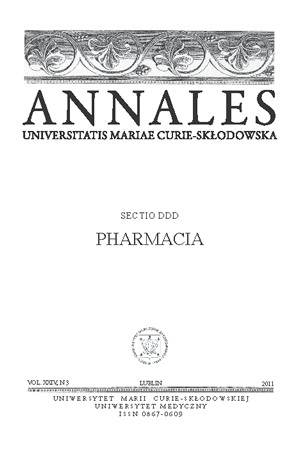Antihypertensive and antioxidative activity of peptides derived from pea sprouts (Pisum sativum) protein hydrolysates
DOI:
https://doi.org/10.12923/Keywords:
peptides, antihypertensive properties, antioxidative properties, legumesAbstract
Proteins of leguminous plants being a source of bioactive peptides characterized by antioxidant and blood pressure lowering properties, can contribute to the prevention of the development of many civilization diseases by inhibiting free radical reactions and delaying the process of cell aging. In this study antioxidative and ACE (angiotensin I-converting enzyme) inhibitory activity of peptides obtained from pepsin hydrolysis of proteins of pea sprouts, were studied. During hydrolysis, the peptides content increased slightly to 21.86 mg/ml, the IC50 value of ACE inhibitory activity was 1.59 mg/ml and anti-radical activity and ability to chelating of Fe2+ was 99.57% and 84.35%, respectively. The pea sprouts protein hydrolysate was separated by DEAE cellulose. The highest hypotension activity was obtained in sixth fraction (IC50-0.36mg/ml), which was fractionated using Sephadex G10 resin. The received fraction demonstrated inhibitory activity at 60.95 % with regard to ABTS•+, and ability to chelating of Fe2+ at 75.38%, while IC50 value of ACE inhibitory peptide was 0.69 mg/ml. In conclusion, pea sprouts are a source of bioactive peptides, which have antihypertensive and antioxidant properties, released in the process of their digestion using pepsin. This suggests that these hydrolysates can be used for production of new preparations having a favorable effect on human health or can be applied as additives to functional food increasingly popular among customers.
References
1. Adler-Nissen J: Determination of the degree of hydrolysis of food protein hydrolysates by trinitrobenzenosulfonic acid. J. Agric. Food Chem., 27, 1256, 1979.
2. Akıllıog˘lu H, Gul Ć, Karakaya S: Effects of heat treatment and in vitro digestion on the angiotensin converting enzyme inhibitory activity of some legume species. Eur Food Res. Technol., 229, 915, 2009.
3. Bamdad F et al.: The impact of germination and in vitro digestion on the formation of angiotensin converting enzyme (ACE) inhibitory peptides from lentil proteins compared to whey proteins. Int. J. Biol. Sci., 5, 2, 2009.
4. Beckman K, Ames B: The free radical theory of aging matures. Physiol. Rev., 78, 547, 1998.
5. Boye J et al. Ribereau S, Mondor M., Farnworth, E.: Comparison of the functional properties of pea, chickpea and lentil protein concentrates processed using ultrafiltration and isoelectric precipitation techniques. Food Res. Internat., 43, 2, 537, 2010.
6. Decker E, Welch B: Role of ferritin as a lipid oxidation catalyst in muscle food. J. Agric. Food Chem., 38, 674, 1990.
7. Gao D et al.: Angiotensin I-converting enzyme inhibitor derived from cottonseed protein hydrolysates. Afr. J. Biotechnol., 53, 8977, 2010.
8. Hollenberg N.: Treatment of hypertension: the place of angiotensin-converting enzyme inhibitors in the nineties. J. Cardiovasc. Pharmacol., 20, 29, 1992.
9. Kansci G et al.: The antioxidant activity of carnosine and its consequences on the volatile profiles of liposomes during iron/ ascorbate induced phospholipid oxidation. Food Chem., 60, 165, 1995.
10. Mallikarjun G et al.: Angiotensin I-converting enzyme inhibitory peptide derived from glycinin, the 11S globulin of soybean (Glycine max). J Agric Food Chem., 54, 4568, 2006.
11. Marczak E et al.: New antihypertensive peptides isolated from rapeseed. Peptides, 24, 791, 2003.
12. Megias C et al.: Purification of an ACE inhibitory peptide after hydrolysis of sunflower (Helianthus annuus L.) protein isolates. J. Agric. Food Chem., 52, 1928, 2004.
13. Pihlanto A, Akkanen S, Korhonen H.: ACE-inhibitory and antioxidant properties of potato (Solanum tuberosum). Food Chem., 109, 104, 2008.
14. Sokołowska A, Polanowski A (2005): Rodzina białek bogatych w prolinę – struktura, niektóre funkcje i perspektywy wykorzystania. Praca zbiorowa pod red. Koroniak H., Barciszewski J., Na pograniczu chemii i biologii, Wyd. UAM Poznań,16,.
15. Xie Z et al.: Antioxidant activity of peptides isolated from alfalfa leaf protein hydrolysates. Food Chem. 111, 370, 2008.
16. Zhang T et al.: Purification and characterisation of a new antioxidant peptide from chickpea (Cicer arietium L.) protein hydrolysates. Food Chem., 28, 2011.
Downloads
Published
Issue
Section
License
Copyright (c) 2011 Authors

This work is licensed under a Creative Commons Attribution-NonCommercial-NoDerivatives 3.0 Unported License.


